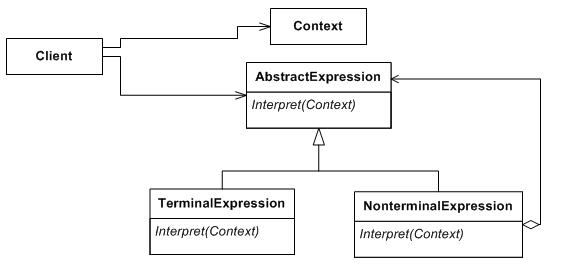Interpreter
JaninaVoigt (Talk | contribs) |
|||
| Line 1: | Line 1: | ||
The interpreter pattern is specific implimentation of the [[Composite|composite pattern]] generally used for language parsing. In the interpreter pattern a class is produced for each symbol in the language. A statement can then be broken down into a syntax tree of these classes which can in turn be used to interpret the statement. | The interpreter pattern is specific implimentation of the [[Composite|composite pattern]] generally used for language parsing. In the interpreter pattern a class is produced for each symbol in the language. A statement can then be broken down into a syntax tree of these classes which can in turn be used to interpret the statement. | ||
| + | ==Use When== | ||
| + | You should use Interpreter when there is a language that you need to interpret and when the statements of the language can be represented as abstract syntax trees. It works best when: | ||
| + | * the grammar of the language is simple. Otherwise, the class hierarchy for the grammar becomes large and complex. | ||
| + | * efficiency is not essential. | ||
| − | == | + | ==Structure== |
| − | * [[Composite]] | + | |
| + | [[Image:Interpreter.jpg]] | ||
| + | |||
| + | ==Participants== | ||
| + | ===Abstract Expression=== | ||
| + | |||
| + | ===Terminal Expression=== | ||
| + | |||
| + | ===Nonterminal Expression=== | ||
| + | |||
| + | ===Context=== | ||
| + | |||
| + | ===Client=== | ||
| + | |||
| + | == Related Patterns == | ||
| + | * [[Composite]]: The abstract syntax tree uses a [[Composite]] pattern. | ||
| + | * [[Flyweight]]: This pattern can be used to share the terminal symbols. | ||
| + | * [[Iterator]]: This pattern can be used to traverse the Interpreter structure. | ||
| + | * [[Visitor]]: This pattern can be used to collect the behavior for all abstract syntax tree nodes in one class. | ||
[[Category:Design Patterns]] | [[Category:Design Patterns]] | ||
Revision as of 00:48, 25 July 2009
The interpreter pattern is specific implimentation of the composite pattern generally used for language parsing. In the interpreter pattern a class is produced for each symbol in the language. A statement can then be broken down into a syntax tree of these classes which can in turn be used to interpret the statement.
Contents |
Use When
You should use Interpreter when there is a language that you need to interpret and when the statements of the language can be represented as abstract syntax trees. It works best when:
- the grammar of the language is simple. Otherwise, the class hierarchy for the grammar becomes large and complex.
- efficiency is not essential.
Structure
Participants
Abstract Expression
Terminal Expression
Nonterminal Expression
Context
Client
Related Patterns
- Composite: The abstract syntax tree uses a Composite pattern.
- Flyweight: This pattern can be used to share the terminal symbols.
- Iterator: This pattern can be used to traverse the Interpreter structure.
- Visitor: This pattern can be used to collect the behavior for all abstract syntax tree nodes in one class.
| Design patterns | |
|---|---|
|
Creational: Abstract Factory | Builder | Factory Method | Prototype | Singleton | |
